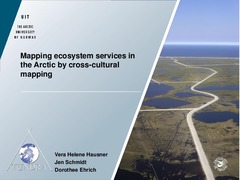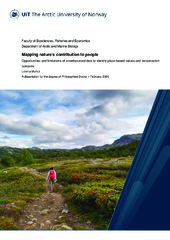Browsing Fakultet for biovitenskap, fiskeri og økonomi by Title
Now showing items 2935-2954 of 5087
-
Management of the alien invasive red king crab Integrating natural and social science perspectives
(Doctoral thesis; Doktorgradsavhandling, 2012-06-12)The red king crab (Paralithodes camtschaticus) is a highly valuable resource that also represents a potential threat since it is an alien invasive species in the Barents Sea ecosystem. This thesis explores the use of different interdisciplinary frameworks to analyse how ecological, social and economic concerns could be accounted for in deciding on how the king crab should be managed in the Norwegian ... -
Management systems for oil and gas operations. Comparision of Russian and Norwegian regulations and their possible impacts on fisheries in the Barents Sea
(Master thesis; Mastergradsoppgave, 2006-09-14) -
Management, markets and politics: Statistical screening for historical footprints in Arctic coal mining
(Journal article; Tidsskriftartikkel; Peer reviewed, 2011-11-29)The paper looks at the economic performance of the main (coal mining) company operating in Svalbard based on time series data from 1922 to 2006 and uses statistical techniques to detect structural breaks in economic indicators decomposed into components that the company control or influence and components that are exogenous. The analysis suggests distinctive historical periods and illustrates that ... -
Managerial Incentives for Technology Transfer
(Working paper; Arbeidsnotat, 2008-03-27)This paper studies how a separation of ownership and management affects a firm’s incentives to transfer knowledge about technology to a rival in a Cournot duopoly. We consider a three-stage strategic delegation game, where there are two technologies available; one with increasing returns to scale and the other with constant returns to scale. Whilst the former is known to both firms, only the ... -
Managing knowledge resources
(Journal article; Tidsskriftartikkel; Peer reviewed, 2016)This article discusses the development of the type of knowledge held to be crucial for creativity and innovation, and which is referred to here as hidden knowledge. The research question investigated is: How can organizations develop hidden knowledge? The first purpose of the article is to bring forth a type of knowledge which can give some foundation for knowledge management and innovation. The ... -
Managing size selectivity: the relevance of compulsory and alternative selection devices in the Northeast Atlantic bottom trawl fishery
(Journal article; Tidsskriftartikkel; Peer reviewed, 2022-10-14)Two decades of use of the compulsory selectivity gear configuration in the Northeast Atlantic bottom trawl fishery, which consists of a rigid sorting grid followed by a diamond mesh codend, have revealed problems with performance and efficiency. Size selectivity gear alternatives to this configuration are being pursued, and recent studies of codends with shortened lastridges have reported promising ... -
Mandibular shape in farmed Arctic foxes (Vulpes lagopus) exposed to persistent organic pollutants
(Journal article; Tidsskriftartikkel; Peer reviewed, 2018-07-26)We investigated if dietary exposure to persistent organic pollutants (POPs) affect mandibular asymmetry and periodontal disease in paired male-siblings of Arctic foxes (<i>Vulpes lagopus</i>). During ontogeny, one group of siblings was exposed to the complexed POP mixture in naturally contaminated minke whale (<i>Balaenoptere acutorostarta</i>) blubber (n = 10), while another group was given wet ... -
Manipulating the Epigenetic Machinery of Marine Fungi Through the Application of Epigenetic Modifiers to Induce the Biosynthesis of Novel Secondary Metabolites
(Master thesis; Mastergradsoppgave, 2020-05-15)Fungi are among the most prolific producers of secondary metabolites, many of which have huge utility for society as various anti-infective and anticancer drugs. The genes encoding these secondary metabolites are arranged in continuous biosynthetic gene clusters (BGCs). Each fungus can have tens of different BGCs in its genome, possessing the ability to produce a multitude of secondary metabolites ... -
Mantle source heterogeneity in a Neoproterozoic back-arc basin: Geochemical and thermodynamic modeling of the volcanic section of Wadi Ghadir ophiolite, Egypt
(Journal article; Tidsskriftartikkel; Peer reviewed, 2021-12-02)Wadi Ghadir ophiolite in the Egyptian Eastern Desert, which forms the northern part of the Nubian Shield, is considered as one of the best-preserved segments of the Neoproterozoic oceanic lithosphere on Earth. Primary melt calculations and thermodynamic modeling of new geochemical data for the Wadi Ghadir pillow lavas and dike complexes, integrated with comprehensive petrographic investigations, are ... -
The Map of Sea Turtle Rescue Centres in the Mediterranean
(Conference object; Konferansebidrag, 2016-09-12) -
MapMan4: a refined protein classification and annotation framework applicable to multi-omics data analysis.
(Journal article; Tidsskriftartikkel; Peer reviewed, 2019-01-09)Genome sequences from over 200 plant species have already been published, with this number expected to increase rapidly due to advances in sequencing technologies. Once a new genome has been assembled and the genes identified, the functional annotation of their putative translational products, proteins, using ontologies is of key importance as it places the sequencing data in a biological context. ... -
Mapping ecosystem services in the Arctic by cross-cultural PPGIS
(Conference object; Konferansebidrag, 2014) -
Mapping nature’s contribution to people: Opportunities and limitations of crowdsourced data to identify place-based values and conservation concerns
(Doctoral thesis; Doktorgradsavhandling, 2020-06-16)Nature provides people with a wide range of benefits, also known as nature’s contributions to people (NCP). The NCP framework evolved from the Ecosystem services (ES) concept as a response to the critiques and misconceptions associated with ES over the last years. Broadening ES valuations that have been dominated by economic valuations, the NCP framework emphasizes a pluralistic approach to valuation ... -
Mapping species distributions: a comparison of skilled naturalist and lay citizen science recording
(Journal article; Tidsskriftartikkel; Peer reviewed, 2015-10-27)To assess the ability of traditional biological recording schemes and lay citizen science approaches to gather data on species distributions and changes therein, we examined bumblebee records from the UK’s national repository (National Biodiversity Network) and from BeeWatch. The two recording approaches revealed similar relative abundances of bumblebee species but different geographical distributions. ... -
Mapping the Historical Shipwreck Figaro in the High Arctic Using Underwater Sensor-Carrying Robots
(Journal article; Tidsskriftartikkel; Peer reviewed, 2020-03-19)In 2007, a possible wreck site was discovered in Trygghamna, Isfjorden, Svalbard by the Norwegian Hydrographic Service. Using (1) a REMUS 100 autonomous underwater vehicle (AUV) equipped with a sidescan sonar (SSS) and (2) a Seabotix LBV 200 mini-remotely operated vehicle (ROV) with a high-definition (HD) camera, the wreck was in 2015 identified as the Figaro: a floating whalery that sank in 1908. ... -
Mapping uncertainties in the upstream : the case of PLGA Nanoparticles in Salmon Vaccines.
(Journal article; Tidsskriftartikkel; Peer reviewed, 2011)The diversity of nanotechnologies and of the governance challenges that their applications raise calls for exploration and learning across different cases. We present an Upstream Oversight Assessment (UOA) of expected benefits and potential harms of nanoparticles made of a synthetic polymer (PLGA) to improve vaccines for farmed salmon. Suggested by Jennifer Kuzma and colleagues, an UOA may help ... -
Marinated shrimp as a dinner option. Consumer evaluations and use of a new convenience product
(Master thesis; Mastergradsoppgave, 2006-06-02)The purpose of this thesis is to investigate consumer use and evaluations of a new shrimp (Pandalus borealis) product, Stella marinated shrimp, to increase knowledge about the perception and how this new product is used in the kitchen by consumers. The main objective is; ”To examine how consumers evaluate and use a new convenience product, the case of Stella marinated shrimp”. To explore ... -
Marine artificial light at night: An empirical and technical guide
(Journal article; Tidsskriftartikkel; Peer reviewed, 2021-06-04)1. The increasing illumination of our world by artificial light at night (ALAN) has created a new field of global change research with impacts now being demonstrated across taxa, biological ranks and spatial scales. Following advances in terrestrial ecology, marine ALAN has become a rapidly growing research area attracting scientists from across all biomes. Technological limitations, complexities ... -
The marine biodiscovery pipeline and ocean medicines of tomorrow
(Journal article; Tidsskriftartikkel; Peer reviewed, 2016-01-01)Marine organisms possess the capacity to produce a variety of unique and biologically potent natural products for treating human diseases, many of which are currently commercially available or are in advanced clinical trials. Here we provide a short review on progress in the field and discuss a case study of an EU-funded project, PharmaSea, which aims to discover novel products for the treatment of ... -
Marine biomonitoring with eDNA: Can metabarcoding of water samples cut it as a tool for surveying benthic communities?
(Journal article; Tidsskriftartikkel; Peer reviewed, 2020-09-24)In the marine realm, biomonitoring using environmental DNA (eDNA) of benthic communities requires destructive direct sampling or the setting‐up of settlement structures. Comparatively much less effort is required to sample the water column, which can be accessed remotely. In this study we assess the feasibility of obtaining information from the eukaryotic benthic communities by sampling the adjacent ...


 English
English norsk
norsk


















